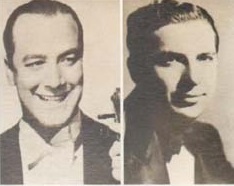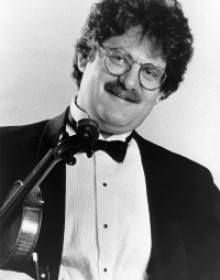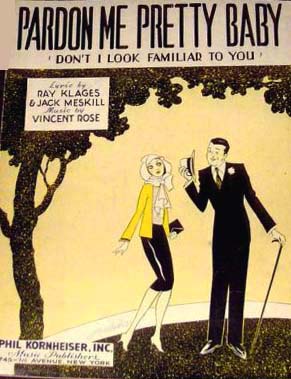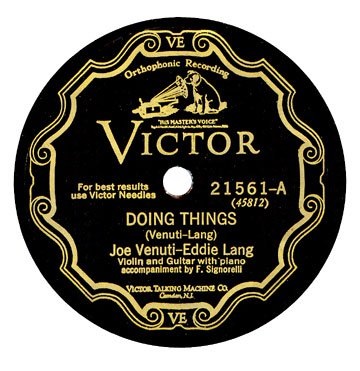
Joe Venuti and Eddie Lang. Photo courtesy musicstack.com
Joe Venuti was the first star of jazz violin. With guitarist Eddie Lang, he pioneered the role of string instruments in jazz. However, in the folklore of early jazz, ‘The Wild Fiddler of Philly” is just about equally well known for his relentless practical jokes. Mention Venuti’s name in a group of musicians and a hundred funny stories pop up. On this edition of Riverwalk Jazz we enter the wild world of Joe Venuti and his musical partner—guitarist Eddie Lang.
Shortly after World War I, Joe Venuti found himself playing classical violin with a Philadelphia symphony. Stiff competition in the violin section, led him to pursue jazz music on violin, he said “his chances of making it to the top were good since there was no competition.” Jazz bands of the time rarely had a violin in the lineup.
.jpg)
Joe Venuti. Photo courtesy redhotjazz
Bandleader Jim Cullum says, “Venuti’s idea to play jazz on an instrument that was considered strictly a classical was a part of his ticket to stardom. He brought the same freedom and abandon, the same harmonic feeling and syncopation to the violin that the Bix Beiderbecke brought to the cornet. Like Bix, Venuti was an amazing character—completely in a class by himself. His playing matched his wild personality. He always had a carefree, fun sound to his playing.”
Radio Show Playlist Notes
Jazz violinist Andy Stein and acoustic guitarist Marty Grosz sit in with The Jim Cullum Jazz Band on the following Bix Beiderbecke-Joe Venuti collaborations on this radio show:
“Dinah,” “My Pretty Girl Stomp,” “I'm Gonna Meet My Sweetie Now” and “The Baltimore,” a tune composed by Jimmy McHugh in 1927 named for a popular dance. The Jim Cullum Jazz Band’s arrangement of “The Baltimore” heard here features the original Bix chorus.
Joe Venuti’s practical jokes have attained mythic status among musicians. Guests Andy Stein and Marty Grosz share some of their favorites with Jim Cullum, host David Holt, and the studio audience at The Landing jazz club. Highlights of this broadcast are clips from a Dick Cavett television show interview with Joe Ventui sharing an inside line on his favorite practical jokes, pulled while on the road with Bix Beiderbecke and other musicians.

Andy Stein photo courtesy of the artist
Andy Stein talks with host David Holt about Venuti’s classical foundation on his instrument: “He was a very fine violinist with a great sound and rhythm, and he could play anything that came into his head.” Stein also points out that Venuti often incorporated melodic fragments of classical pieces he knew—such as “The Girl with the Flaxen Hair”—into his jazz tunes and improvisations. Stein explains that Venuti also made extensive use of ‘blue’ notes and blues tonality not found in classical music.
Joe Venuti composed a body of virtuoso showcases; “Hell’s Bells and Hallelujah,” “Doin' Things” and “Beatin' the Dog” are interpreted here by Andy Stein, Marty Grosz and members of the Cullum Band rhythm section.
Musicians seem to have an infinite supply of Venuti stories and memories. What we don’t often hear about Venuti is that he was a loner at heart, who liked to spend time by himself listening to opera. Vince Giordano was in his twenties when he first played with Joe Venuti at Carnegie Hall, and Giordano remembers Joe as being almost grandfatherly backstage, though in front of an audience he never let up.

Marty Grosz photo courtesy of the artist
Marty Grosz on Eddie
Lang
Special guest guitarist Marty
Grosz describes Eddie Lang’s
contribution to. “Eddie Lang
started the jazz guitar. He was
really the first guitarist of
national recognition. He was in
the right place at the right
time.” Grosz goes on to explain
that it wasn’t until the
adoption of the electric
microphone in 1925 that the
guitar could be heard above
other jazz band instruments,
especially in noisy dance halls
or on radio broadcasts from
nightclubs. “With the
microphone, all of a sudden you
could hear Eddie Lang, and all
the banjo players said, ‘What’s
that?’ Not only could you hear
him, he was terrific. The next
thing you know, all the guys
were studying the six-string
guitar, and the banjos were
hanging up in the pawn shops.”
Joe Venuti and his best friend Eddie Lang were both born in 1904. Joe and Eddie grew up together in Philadelphia where they went to grade school and studied music. They were taught music by the solfeggio method, learning to sing notes before playing them on an instrument. As kids, Joe and Eddie both played violin and guitar. When asked why he settled on violin, Venuti said his grandfather gave him the instrument. He told a different story to guitarist Les Paul. Venuti said he and Lang flipped a coin in front of a pawnshop where a violin and a guitar were in the window. “It was the flip of a coin, that’s the reason they played the instruments they did,” says Les Paul, “otherwise it would have been reversed. That’s what Joe told us—whether it’s true or not, that’s up to Joe!” After Eddie Lang’s death, Joe Venuti presented Les Paul with Eddie’s guitar.

"Pardon Me Pretty Baby" sheet music, 1931. Image courtesy kampko.com
Though the legendary Venuti - Lang duo ended unexpectedly when Eddie Lang died in 1933, Joe Venuti’s star continued to rise and he went on to form his own big band, played in studio sessions and on radio and television. Yet he always revered the memory of his first partner. In memory of his longtime partner, Joe Venuti would pull out tunes that reminded him of his friend, such as the Bix Beiderbecke-Eddie Lang duet on “I'm Comin' Virginia.” Or, a number Venuti and Lang often played together, “Pardon Me, Pretty Baby,” performed here by the full Band with guests Andy Stein and Marty Grosz.
Joe Venuti rose to the top and stayed there. He played major recording dates with bandleaders like Red Nichols, Hoagy Carmichael, Paul Whiteman and the Dorsey Brothers. He took part in the premiere of Gershwin’s Rhapsody in Blue in 1924 and made jazz history with his own ensemble—the Blue Four—in the 1930s. He was a regular on Bing Crosby’s national radio broadcast series throughout the 1950s, famous for his opening line, “Is this the place?” Even in his old age, fighting cancer, he kept up a constant schedule of appearances around the world until his death in 1978.

Venuti-Lang record label courtesy78records.wordpress.com
Jim Cullum notes that late in his life, “Joe never rested. He went on to form many interesting musical partnerships. Among others, he teamed up with saxophonist Zoot Sims to record the old jam standard “My Honey’s Lovin’ Arms.” On this radio show, the original Venuti-Sims historical recording is heard followed by a live crossfade to a live performance on stage at The Landing with Stein on violin, Brian Ogilvie on tenor sax and members of the Cullum Band rhythm section.
By the early 1960s, a lifetime of hard drinking and gambling had taken its toll, and Joe Venuti’s career fell into decline. A comeback in 1967—at a Dick Gibson jazz party in Colorado—sparked new interest in his music, and once again he was a hot property. Marty Grosz shares backstage memories from time spent with his hero, playing impromptu jam sessions that would go on on for hours. Grosz says,“For me, playing with Joe Venuti was akin to being with Ellington or Armstrong or Bix —a lifelong dream.”
Photo credit for Home Page. Joe Venuti and Eddie Lang courtesy Amazon.com
Text based on Riverwalk Jazz script by Margaret Moos Pick ©1993

